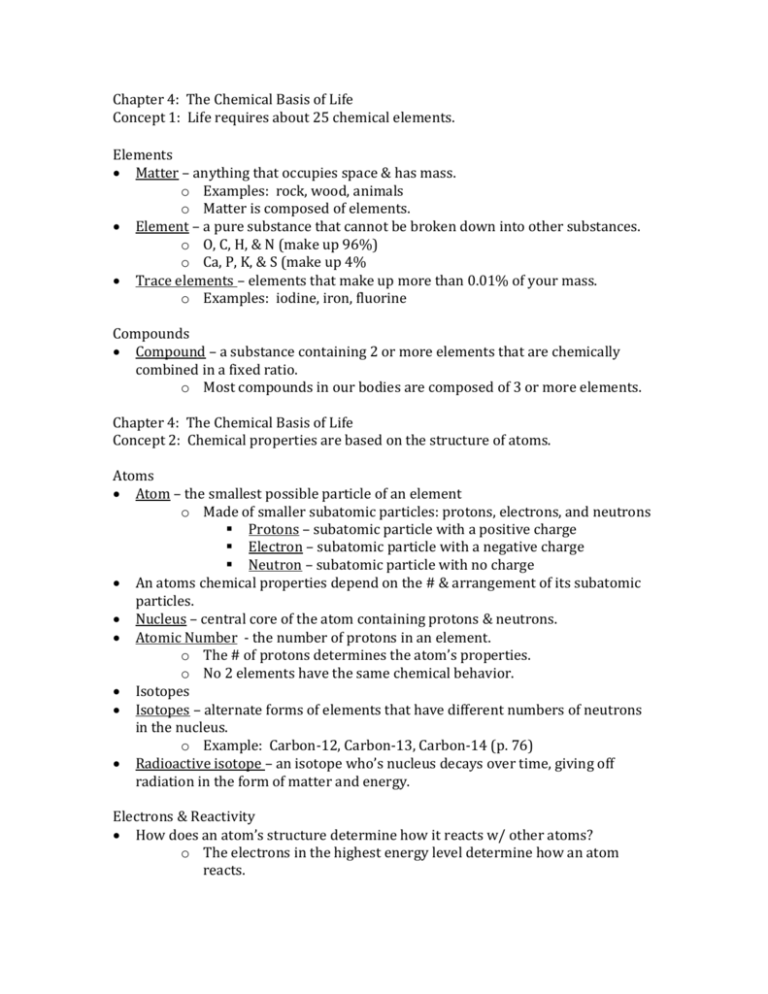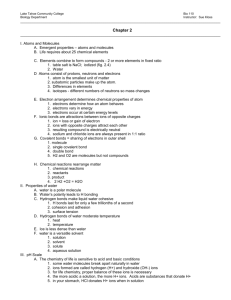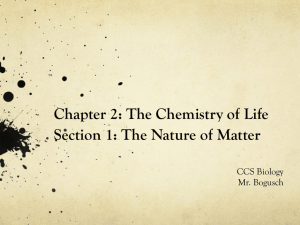chpt.4notes - Haiku Learning
advertisement

Chapter 4: The Chemical Basis of Life Concept 1: Life requires about 25 chemical elements. Elements Matter – anything that occupies space & has mass. o Examples: rock, wood, animals o Matter is composed of elements. Element – a pure substance that cannot be broken down into other substances. o O, C, H, & N (make up 96%) o Ca, P, K, & S (make up 4% Trace elements – elements that make up more than 0.01% of your mass. o Examples: iodine, iron, fluorine Compounds Compound – a substance containing 2 or more elements that are chemically combined in a fixed ratio. o Most compounds in our bodies are composed of 3 or more elements. Chapter 4: The Chemical Basis of Life Concept 2: Chemical properties are based on the structure of atoms. Atoms Atom – the smallest possible particle of an element o Made of smaller subatomic particles: protons, electrons, and neutrons Protons – subatomic particle with a positive charge Electron – subatomic particle with a negative charge Neutron – subatomic particle with no charge An atoms chemical properties depend on the # & arrangement of its subatomic particles. Nucleus – central core of the atom containing protons & neutrons. Atomic Number - the number of protons in an element. o The # of protons determines the atom’s properties. o No 2 elements have the same chemical behavior. Isotopes Isotopes – alternate forms of elements that have different numbers of neutrons in the nucleus. o Example: Carbon-12, Carbon-13, Carbon-14 (p. 76) Radioactive isotope – an isotope who’s nucleus decays over time, giving off radiation in the form of matter and energy. Electrons & Reactivity How does an atom’s structure determine how it reacts w/ other atoms? o The electrons in the highest energy level determine how an atom reacts. When atoms have partially filled outer electron shells, they are more likely to react. Chapter 4: The Chemical Basis of Life Concept 3: Chemical bonds join atoms to one another. Ionic Bonds Ionic bond – a bond where an atom transfers an electron to another atom. o Before bonding, atoms are neutral (equal #’s of protons and electrons). o After the electron transfer, they are ions. Ion – an electrically charges atom o Fig. 4.8 (p. 78) Covalent Bonds Covalent bond – 2 or more atoms share electrons Number of bonds: o The number of bonds is determined by the number of electrons needed to fill the outer energy level. Molecule – 2 or more atoms that are bonded together by a covalent bond. o 3 types of models to represent molecules (fig. 4-10, p.79): Chemical formula Space filling Structural Chemical Reactions Chemical reaction – the breaking of old and formation of new chemical bonds that results in new substances. (fig. 4-11, p. 80) o Some reactions absorb energy o Some release energy Reactants – materials present before the reaction Products – materials present after the reaction Chemical reactions do not create or destroy atoms; they only rearrange them. Chapter 4: The Chemical Basis of Life Concept 4: Life depends on the unique properties of water. Water H2O Why is it important to you? o The fluid that surrounds your cells contains mostly water. o Your cells are composed of 70% – 95% of water. The Structure of Water Composed of 1 Oxygen atom covalently bonded to 2 hydrogen atoms. Polar molecule – a molecule in which opposite ends have opposite electric charges. WHY? o There is an unequal sharing of electrons. O’s nucleus has more protons, making it stronger. o “V” shaped molecule o Fig. 4-12, p. 81 o Water molecules are attracted to each other due to them having a “positive” end & a “negative” end. o This is a weak attraction known as a hydrogen bond. Hydrogen bond – a chemical bond created b/w a slightly positive hydrogen atom & a slightly negative portion of another molecule. o Fig. 4-12. p. 81 o Not as strong as an ionic bond Water’s Life Supporting Properties Cohesion Adhesion Temperature moderation Low density of ice Water’s ability to dissolve other substances Cohesion & Adhesion o Cohesion – the tendency of molecules of the same kind to stick to one another Hydrogen bonds last for less than a second, yet they form new bonds just as quickly. Surface tension – the affect of cohesion pulling water molecules together to create a “film”. (p.82) o Adhesion – the type of attraction that occurs between unlike molecules. o Important to life b/c they allow large molecules to stay together and function properly in cells. o See “tree” example on p.82, fig. 4-13. Temperature Moderation o Thermal energy – the total amount of energy associated with the random movement of atoms & molecules in a sample of matter. o Temperature – a measure of the average energy of random motion of the particles in a sample of matter. o When 2 substances differ in temperature, the warmer substance transfers thermal energy in the form of heat to the cooler substance. o B/c of hydrogen bonding, H2O has a better ability to resist temperature changes than most substances. WHY? Heating water (metal pan vs. H2, p. 83) Some of the thermal energy absorbed to H2O is used to break the hydrogen bonds, causing water to heat up slower. Cooling water As H2O cools, hydrogen bonds are also forming. The formation releases heat, causing the water to cool slowly. o Why does this matter? It helps regulate air temperature. It helps cool our bodies when we sweat. Low Density of Ice o Why does ice have a lower density than water? Hydrogen bonds allow there to be spaces between water molecules. When the H2O if in solid state, there is not enough energy to break the hydrogen bonds. o Why does it matter that ice floats on water? When ice is on top of the water, it insulates the water underneath so that organisms can survive. Water’s Ability to Dissolve Other Substances Solution – a uniform mixture of 2 or more substances o Solvent – the substance that dissolves another substance o Solute – the substance that is dissolved Aqueous Solution – a solution where water is the solvent o Since H2O is a polar molecule, the slightly charged ends attract the ions or atoms of the solute to break apart the bonds and dissolve them. Acids, Bases, and pH In aqueous solutions, a small percentage of water molecules break apart into ions. The ions formed are positive H (H+) & negative OH (OH-). Acid – a compound that donates H+ ions to a solution. Base – a compound that removes H+ ions from an aqueous solution. o Some add OH- ions. Fig. 4-17, p. 85 pH Scale – describes how acidic or basic a solution is o Ranges from 0 – 14. 0 most acidic 14 most basic o Each pH unit represents a tenfold change in concentration of H+ ions. Example: lemon juice with a pH of 2 has 10 times more H+ ions than grapefruit juice with a pH of 3. o The pH in most living cells is around 7. Buffers – substances that cause a solution to resist changes in pH. o A buffer accepts H+ ions when there are too many, and donating H+ ions when there is not enough. o Biological fluids contain buffers to regulate pH levels.








